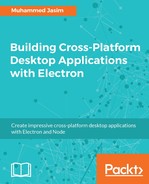Book Description
Learn how to develop cross-platform desktop app from scratch with Electron and Node
About This Book
- Build a solid foundation with Electron for an easier development experience
- Use modern JavaScript frameworks and tools along with Electron to take your desktop applications to the next level
- Extend the functionality of Electron through modules
Who This Book Is For
If you are a developer with prior experience of building front-end applications and you are keen on developing a cross-platform desktop application, then this book is for you. This book is also ideal for experienced JavaScript developers with a basic understanding of front-end development and Node.js development.
What You Will Learn
- Explore various tools and libraries to build and debug an Electron application
- Use popular JavaScript frameworks such as Angular and Typescript along with Electron to enhance your app
- Work with the desktop UI development for Electron using Photon
- Find out how to use various Electron APIs like Clipboard, Process, Shell, Image, File, Session, and Cookie
- Integrate your application into different desktop environments with Electron API
- Cache your network resources using service worker
- Test the Electron application using Mocha and Spectron
- See how to package and distribute an Electron application
In Detail
Though web applications are becoming increasingly popular, desktop apps are still important. The Electron framework lets you write cross-platform desktop applications using JavaScript, HTML, and CSS, and this book will teach you how to create your first desktop application with Electron. It will guide you on how to build desktop applications that run on Windows, Mac, and Linux platforms.
You will begin your journey with an overview of Electron, and then move on to explore the various stages of creating a simple social media application. Along the way, you will learn how to use advanced Electron APIs, debug an Electron application, and make performance improvements using the Chrome developer tools. You'll also find out how to package and distribute an application, and more.
By the end of the book, you will be able to build a complete desktop application using Electron and web technologies. You will have a solid understanding of the common challenges that desktop app developers face, and you'll know how to solve them.
Style and approach
Covers everything you need to know about Electron with full examples and explanations to get you building desktop apps with Electron as quickly as possible.
